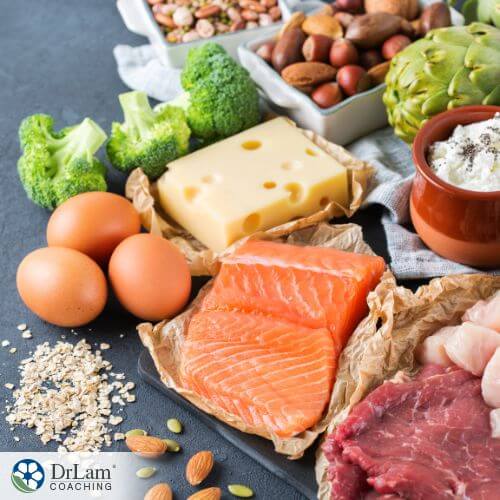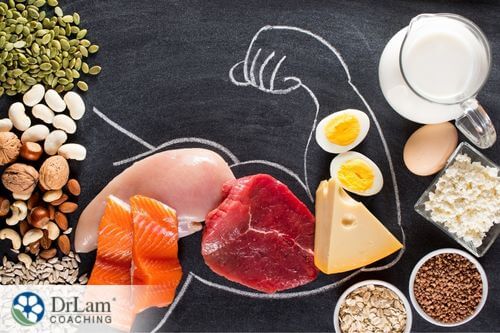 Your dietary protein includes sources of protein foods. These foods are important for growth and tissue repair, building and maintaining muscles, bones, and skin, and play a key role in hormone regulation and digestion. Being mindful of the quantity and sources of proteins is essential for promoting optimal health and minimizing the risk of serious health problems, like cardiovascular issues. A balanced intake of high-quality plant and animal proteins can supply the necessary nutritional benefits and limit the development of risk factors.
Your dietary protein includes sources of protein foods. These foods are important for growth and tissue repair, building and maintaining muscles, bones, and skin, and play a key role in hormone regulation and digestion. Being mindful of the quantity and sources of proteins is essential for promoting optimal health and minimizing the risk of serious health problems, like cardiovascular issues. A balanced intake of high-quality plant and animal proteins can supply the necessary nutritional benefits and limit the development of risk factors.
You need dietary protein to help your body to perform at an optimal level, repair itself, and to protect it from foreign invaders like bacteria and viruses. Protein food sources provide the necessary essential nutrients, like iron, magnesium, B vitamins, zinc, and omega-3 fatty acids. A deficiency of protein in the diet can cause edema, fatty liver, flaky skin, hair loss, muscle mass loss, increased risk for bone fracture, and impaired growth in children.
Both plant and animal sources provide dietary protein that the body needs. Animal proteins are referred to as ‘complete proteins’ because they contain all of the essential amino acids. They are considered high-quality proteins. Examples of animal protein foods include:
Plant proteins are referred to as ‘incomplete proteins’ because they typically miss at least one of the essential amino acids. Examples of plant proteins include:
There are some sources of protein that can be considered of a lower quality because they are usually high in saturated fats, have limited beneficial nutrients, and as a result, are associated with increased risk of heart disease or worsening an existing health condition, like kidney disease.
These include:
While a high-protein diet can be beneficial if you are healthy, an excessively high-protein diet can be problematic. Protein foods have a combination of protein and other nutrients like vitamins E, polyunsaturated fat, saturated fat, folate, and vitamin B6, making it important to pay attention to the quantity and sources of protein you consume to avoid developing certain risk factors.
Certain dietary protein sources can help to control risk factors for metabolic syndrome or increase them. Metabolic syndrome or MetS refers to a cluster of common cardiovascular risk factors, that includes high blood pressure, high blood sugar, high cholesterol levels, and abdominal fat, which together increase the chance of developing cardiovascular disease, diabetes, and stroke.
A 2021 study by the Journal of the American Academy of Nutrition and Dietetics found that a higher intake of processed meats was linked to an increase in waist circumference, while a higher intake of fish and seafood was linked to a decrease in waist circumference. And intake of unprocessed poultry was linked to a decrease in triglycerides, a fat (lipid) found in the blood.
The association between specific protein-rich sources and changes in MetS components suggests that ‘healthier’ protein sources (specifically unprocessed poultry, fish, and seafood vs processed meats) are more helpful in controlling MetS risk factors, which can impact cardiovascular health.
If you are at risk for heart disease, you should be cautious about your protein intake and speak to your doctor before starting a new diet, especially one that increases protein intake.
 In diets where protein replaces carbohydrates, weight gain is more likely since the excess protein consumed is typically stored as fat. However, a short-term high-protein diet could be beneficial in weight loss, allowing you to feel fuller for longer.
In diets where protein replaces carbohydrates, weight gain is more likely since the excess protein consumed is typically stored as fat. However, a short-term high-protein diet could be beneficial in weight loss, allowing you to feel fuller for longer.
Also note that protein sources like red meats (beef, pork, and lamb) and processed meats (bacon, hot dog, and sausage) are high in saturated fat and can increase your low-density lipoprotein (LDL) cholesterol or “bad” cholesterol, which can lead to weight gain.
If you are having a hard time losing weight, it may be related to signs of Adrenal Fatigue Syndrome(AFS), a condition caused by chronic stress and for which stressors could be the overconsumption of processed foods, unhealthy diet, and food sensitivity, such as dairy. The Cardionomic circuit, which includes the cardiovascular system, the adrenal glands, and the autonomic nervous system (ANS), is activated by stressors, forcing activation of the NeuroEndoMetabolic (NEM) stress response. This increases cortisol levels, which can promote weight gain. Reducing stress, therefore, is essential along with eating healthy levels of dietary protein.
Bad breath with dietary protein intake may be due in part to the body going into ketosis, a metabolic state which produces chemicals that gives off a metallic taste and an unpleasant fruity scent. This occurs when the body has limited carbohydrates to burn for energy and it burns fat instead, making ketones, which it uses for fuel. This odor, which is unlike ordinary halitosis or bad breath, is only a temporary problem that can be remedied by eating less protein, chewing gums, adding natural breath fresheners, like clove or mint, to your water, and boosting your oral hygiene.
Diets high in red meat-based protein are associated with an increased risk of certain cancers: colorectal, breast, pancreas, prostate, and kidney. This is believed to stem from the presence of carcinogenic compounds, ‘bad’ fats, and hormones in meat.
However, protein derived from plant-based sources, like legumes, and whole grains can help to minimize the risk of cancer.
Consuming dietary protein in a manner that is beneficial to support individual needs and optimal health and wellness should be emphasized. This should coincide with any lifestyle changes that can optimize protein benefits.
Since it’s difficult to determine what an optimal protein intake entails, it’s best to stick to the recommended dietary protein intake.
The National Academy of Medicine’s recommendation is that:
However, certain factors can impact how much protein a particular person needs, including gender, health, activity level, and total diet. For example, resistance exercises (e.g. weight lifting) results in greater use of dietary amino acids, making the recommended protein intake less ideal. You may need to talk to your doctor or health coach to determine the ideal amount for you.
A variety of high-quality protein foods are recommended to provide a sufficient supply of amino acids for health benefits, such as lean muscle maintenance, but also meet nutritional needs. This means eating both plant proteins and healthy animal proteins. Also, how you cook your food matters.
The Food and Agriculture Organization of the United Nations (FAO) DIAAS protein quality ranking method emphasizes protein digestibility and absorption of amino acids to support whole body protein use, with a focus on heat application to raw proteins. When applying heat to your raw meat proteins, cook at an internal temperature of 70°C, which increases protein digestibility. Opt for steaming, boiling, and pan-frying, rather than roasting or grilling, for the maximum amino acid nutritional value.
 There are a wide array of protein foods including eggs, meat, poultry, peas and beans, nuts, seafood, soy products, and dairy. These foods provide important nutrients, like protein, iron, B vitamins, magnesium, and zinc that are essential for overall health.
There are a wide array of protein foods including eggs, meat, poultry, peas and beans, nuts, seafood, soy products, and dairy. These foods provide important nutrients, like protein, iron, B vitamins, magnesium, and zinc that are essential for overall health.
Adequate intake of important nutrients is best achieved through eating different protein sources in a meal rather than a single source. If eggs, meat, and poultry are your main protein sources, consider optimizing your protein intake with other options like seafood (salmon, herring, tuna, trout, crab, shrimp, and oysters), soy products, nuts, and seeds. Combining foods with different amino acid profiles, like grains and beans, also helps boost protein quality. You’ll boost your intake of protein, along with vital nutrients as well.
One way to consume less red meat is to focus on boosting your plant-based protein food intake - getting more nuts, beans, peas, and whole grains - while still incorporating some of your favorite animal dietary protein.
It’s also beneficial to swap out your red meats for poultry and seafood and to also focus on lean cuts of meat. Lean beef cuts include top loin and top round of the round steak variety and roasts options like round eye, bottom round, and top round for lean red meat selection. Choose cuts of red meat that show the least amount of marbling, which is an indication of fat, and trim visible fat from your meats before cooking.
Protein is an essential component of your daily diet that is found in a variety of food sources. Some protein foods contain more or less protein, as well as other nutrients. Choosing protein sources with a variety of other nutrients is essential for maintaining a healthy diet. It’s key to pay attention to not only the quantity of protein consumed but the quality to minimize health risks and ensure that the body functions properly.
If you are thinking about starting a high-protein diet and would like assistance in determining if it’s right for you, the team at Dr. Lam Coaching can help. We offer a free** no-obligation phone consultation at +1 (626) 571-1234 where we will privately discuss how proteins can affect any existing health conditions. You can also send us a question through our Ask The Doctor system by clicking here.
Dietary protein is associated with certain risk factors such as cardiovascular disease, cancer, weight gain, and bad breath. Eating less red meat, selecting various protein sources, focusing on quality, and adhering to the recommended amount can help you avoid these risks.
